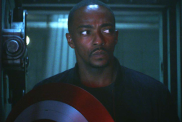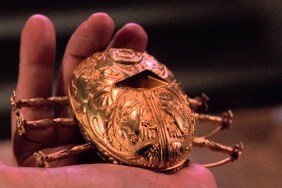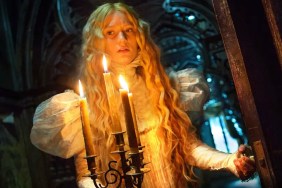
Ive seen some pretty impressive sets over the years, but theres nothing like stepping onto a sound stage and seeing a three-story house sitting right there. In fact, it was such an extensive set that the only way to wrap your head around it in full was by checking out the maquette.
del Toro was absolutely thrilled to show us the 3D model and it quickly became clear why. After creating it using a computer-based design program, production designer Thomas E. Sanders decided to carve the interior in architectural foam himself and the finished product was incredible.
Having just observed the scene during which Wasikowska pushes open the houses enormous double doors, steps out into blizzard-like conditions, turns back and stumble inside, the first striking component of the maquette was that very entrance. While that portion of the house is somewhat majestic, the slight decay on the grey stone and the harsh, triangular shape of the entryway bears a threatening quality.
del Toro then removed the roof of the structure revealing Sanders impeccable foam work. But of course, without working lighting, the tiny interiors were rather dark, so del Toro and his team lit up the mini set with iPhone flashlights so we could appreciate the intricacies inside.
As we saw during filming, just beyond those double doors is an enormous foyer with a set of stairs off to the left that snake around the entire room, leading all the way up to the third floor of the house. Del Toro essentially walked us right up them, stopping to show off the gorgeous detail in every space, the most striking of which was definitely a second floor hallway that had a toothed arc every few feet, giving the space a dizzying optical illusion-like feel.
After putting the pieces back together and making the maquette whole again, del Toro moved on to discussing the exterior of the third story, which is notably different from the first two floors. Whereas the first and second are surrounded by a solid grey stone, the third floor looked to be constructed out of wood slats, some of which were rotting. del Toro explains, We need to have the house feel a little bit like an organism.The house in the screenplay and in the movie has certain features that make it seem [like] a living organism, and so its decaying. Its sitting in the middle of a field, rotting. So we knew that the top needed to be sort of the most weathered part of the house.
The Actual House
Even after spending a good deal of time showing off the maquette, del Toro was equally thrilled to give up his lunchtime to give us a complete, hour-long tour of the actual set.
Minus the fact that there was a jib and some stray equipment strewn about, it was like stepping into a real house. The foyer was identical to the model with a set of stairs off to the left that crawled all the way around and jutted out on the second floor landing in a grandiose balcony. We steered clear of a pile of snow (from Wasikowska opening and closing the main doors earlier) and made our way straight through the foyer and into the library.

Yet again, this was a complete room from end to end. There was a piano off to the far right, presumably where Chastain will play the lullaby and then, moving left, we hit a seating area with a fireplace and also saw the actual library component of the room, a two-story space of shelves packed with books.

From there, del Toro took us out the right side of the room, past the piano and into the kitchen. The space was particularly dark and somewhat dank, but based on the still from the film we were shown of that very room, it will be significantly brighter after lighting. The kitchen was packed with period-appropriate appliances and had a simple, lengthy table running down the middle. Its an exceptionally well-constructed space, but the most striking component was undoubtedly the eerie elevator bank. It was empty at the time, but does have a working elevator inside that goes all the way up to the third floor and down to the clay mine in the basement.

After our visit to the kitchen, we started making our way up and eventually hit the most stunning component of the entire house the aforementioned hallway. The area was incredibly striking in model-form, but its got a jaw downright dropping effect when you get your first look at it in person. The teeth of the arc molding that run up the wall, across the ceiling and down to the other side are absolutely vicious. If youre standing on the second floor landing and look down at the hallway in its entirety, it almost feels like a living, breathing creature, with rows and rows of teeth ready to swallow you whole. But thats not the case at least as far as we know and we were able to step inside to admire the decaying, moth-decorated wallpaper and find fear in the walls – literally.

Then it was up to the eeriest portion of the home, the third floor. The décor is drastically different up top. The first room we hit was a nursery, but the crib and the rest of the furniture were covered with a thin fabric. During her interview Chastain teased, There was a baby in Lucilles history and did not turn out well for her or for the child. Just at the back of the nursery is where we found the elevator car, a cage made up of iron bars. del Toro also made a point of highlighting a feature just beyond the elevator – the eye of the house, which is essentially a circular window.
As we made our way back down the stairs and out of the house, streaks of red caught my eye. Whether its the red clay or red blood, it certainly does give off the effect that the house is bleeding, just as del Toro intended. He explained, I also liked the idea of them just draining the blood of the earth. You know, the rich family draining the land, like leeching it out. It may not be subtle, but I like it. Sanders further explains, What I always felt was that this house was the fabric of the people that lived in it, the flesh of the people that lived in it, so when you see a crack flowing with clay, thats the blood of the earth. He also added, All down the line it was about this family deteriorating and the house at the same time.
The Mine
While the large majority of Allerdale was sitting right there on the stage, there was obviously no way del Toro and his team would get the OK to dig a basement there as well, so that portion of the structure got its own stage. In the film, the basement will be located directly underneath the house with the elevator shaft going straight down into a lower level packed with clay vats. Theres a thick layer of red lining the basement walls, likely from the clay seepage del Toro described earlier. It also seemed as though the room was caving in because in one section, the roof was cracked and jutted down, revealing the stone buried underneath the clay buildup.
Lucilles Room
Another key component of the house that warranted its own stage was Lucilles room. In the film, the room will be part of the third floor, but at Pinewood, its a triangular structure taking up a small corner of another sound stage. The triangle roof gave the room a confined quality, as did the abundance of highly ornate and patterned décor, clothing and trinkets.
—
No matter what youre hoping to get out of Crimson Peak, the film will surprise big time. Its not the eerie visuals or horrifying jump scares, but the exceptionally detailed character work. Producer Callum Greene joked, Everyone on that set believes theyre right, which is kind of awesome if you talk to them, and scary if youre having a glass of wine.
Hiddleston broke it down further, You cant be too definitive about protagonists, antagonists, good guys, bad guys in this film really because if you see the story from each characters perspective, theyre all justified in their actions because the biography, the world that Guillermo has created is so sophisticated that actually every character is in some sense justified at least in their own mind.
If Crimson Peak can get viewers to root for a noble heroine like Edith, connect to a conflicted antihero like Thomas and feel for someone as damaged as Lucille, this is going to be one especially dynamic haunted house film thatll challenge you to stay on your toes, and assess and reassess the main players and their intentions from start to finish.
Crimson Peak is due in theaters on October 16, 2015.
For even more on Crimson Peak, find Shock’s talk with Guillermo del Toro right here.
Crimson Peak
-
Crimson Peak

-
Crimson Peak

-
Crimson Peak

-
Crimson Peak

-
Crimson Peak

-
Crimson Peak

-
Crimson Peak

-
Crimson Peak

-
Crimson Peak

-
Crimson Peak

-
Crimson Peak

-
Crimson Peak

-
Crimson Peak

-
Crimson Peak

-
Crimson Peak

-
Crimson Peak

-
Crimson Peak

-
Crimson Peak

-
Crimson Peak










